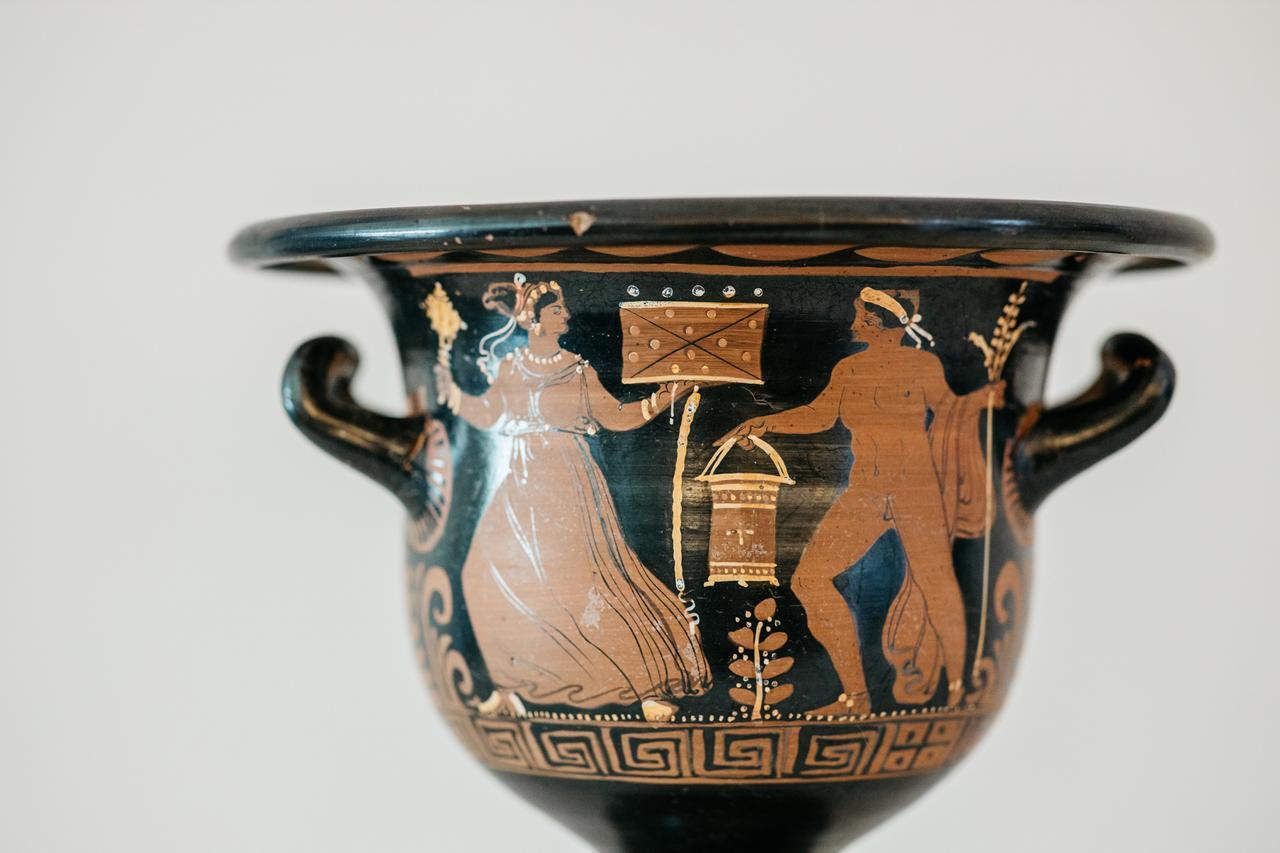Chancay Terakota Figuratywna kulista misa. Wysokość 38 cm. 1000–1400 n.e. Z licencją eksportową na Hiszpanię.





Dodaj do ulubionych, aby otrzymać powiadomienie o rozpoczęciu aukcji.

Kierowała muzeum kolekcji Ifergan, specjalistka w archeologii fenickiej.
Ochrona nabywców Catawiki
Twoja płatność jest u nas bezpieczna, dopóki nie otrzymasz przedmiotu.Zobacz szczegóły
Trustpilot: 4.4 | opinie: 122473
Doskonała ocena na Trustpilot.
Opis od sprzedawcy
Figuralne kuliste naczynie słoikowe.
Chancay, Peru, 1000–1400 n.e.
Terrakota i pigmenty
WYMIARY: 38 cm wysokości i 19 cm średnicy.
Stan dobry, stan oryginalny, nieodrestaurowany, patrz zdjęcia.
Pochodzenie: prywatna kolekcja, Paryż, Francja, utworzona w latach 1960–1980. Z hiszpańską licencją import-export.
Ceramika jest również bardzo powszechnym elementem kultury Chancay. Ta ceramika została znaleziona głównie na cmentarzyskach w dolinach Ancon i Chancay, na przykład w Ancon (miejsce archeologiczne). Cywilizacja Chancay produkowała ceramikę na dużą skalę, korzystając z form. Jednakże znaleziono otwarte naczynia z ponad 400 różnymi wzorami, które jeszcze nie zostały rozszyfrowane, stworzone wyłącznie przez rzemieślników.
Technika używana przy tworzeniu ceramiki polegała na matowej, szorstkiej powierzchni, którą następnie malowano ciemnym kolorem, zazwyczaj czarnym lub brązowym, na tle jaśniejszego kremowego lub białego. Ta cecha, czyli ciemne na jasnym, jest znana jako czarne na białym.
Naczynia są często duże i o nietypowych kształtach. Do najczęstszych należą naczynia w kształcie jajka. Tworzono również ceramiczne lalki lub figurki kobiece. Zazwyczaj były to duże lalki przypominające kobiety, wykonane z gliny. Twarze i czasami górne części ciała pokryte są ozdobami o różnych kształtach geometrycznych. Odlewy tekstyliów na niektórych ceramicznych figurach ludzkich świadczą o tym, że postacie ludzkie, często malowane nago z ozdobami na ciele, były ubierane w prawdziwe ubrania, co nadawało im realizm i energię życiową. Oczy podkreślano liniami po obu stronach, a ramiona zwykle były krótkie. Te geometryczne ozdoby są bardzo powszechne na ceramice Chancay.
Inne powszechne naczynia ceramiczne to obłe słoje z wąskimi szyjami i szerokimi ustami, z wzorami przedstawiającymi ludzkie twarze i kształty geometryczne malowane techniką czarnego na kremowym. Inne popularne kształty zwierząt to ptaki lub lamy. Kolejną częstą grupą przedmiotów były cuchimilcos, małe stojące figurki ludzkiego kształtu z wyraźnie zaznaczonymi szczękami, szerokimi czarnymi oczami pomalowanymi na czarno oraz wyraźnie wyrzeźbionymi genitaliami. Te figurki są szczególnie znane ze względu na ich nietypową pozycję ciała, charakteryzującą się uniesionymi ramionami z dłońmi skierowanymi ku widzowi. Dłonie często były czarne. Figurki te zostały odnalezione w grobowcach szlachty Chancay.
Sprzedawca gwarantuje, że nabył ten przedmiot zgodnie z obowiązującym prawem krajowym i międzynarodowym dotyczącym własności dóbr kultury. Oświadczenie o pochodzeniu widziane przez Catawiki. Przedmiot obejmuje certyfikat autentyczności. Sprzedawca zadba, aby zostały załatwione wszelkie niezbędne pozwolenia.
Ekskluzywne Szufladki Ciekawostek
Historie sprzedawców
Figuralne kuliste naczynie słoikowe.
Chancay, Peru, 1000–1400 n.e.
Terrakota i pigmenty
WYMIARY: 38 cm wysokości i 19 cm średnicy.
Stan dobry, stan oryginalny, nieodrestaurowany, patrz zdjęcia.
Pochodzenie: prywatna kolekcja, Paryż, Francja, utworzona w latach 1960–1980. Z hiszpańską licencją import-export.
Ceramika jest również bardzo powszechnym elementem kultury Chancay. Ta ceramika została znaleziona głównie na cmentarzyskach w dolinach Ancon i Chancay, na przykład w Ancon (miejsce archeologiczne). Cywilizacja Chancay produkowała ceramikę na dużą skalę, korzystając z form. Jednakże znaleziono otwarte naczynia z ponad 400 różnymi wzorami, które jeszcze nie zostały rozszyfrowane, stworzone wyłącznie przez rzemieślników.
Technika używana przy tworzeniu ceramiki polegała na matowej, szorstkiej powierzchni, którą następnie malowano ciemnym kolorem, zazwyczaj czarnym lub brązowym, na tle jaśniejszego kremowego lub białego. Ta cecha, czyli ciemne na jasnym, jest znana jako czarne na białym.
Naczynia są często duże i o nietypowych kształtach. Do najczęstszych należą naczynia w kształcie jajka. Tworzono również ceramiczne lalki lub figurki kobiece. Zazwyczaj były to duże lalki przypominające kobiety, wykonane z gliny. Twarze i czasami górne części ciała pokryte są ozdobami o różnych kształtach geometrycznych. Odlewy tekstyliów na niektórych ceramicznych figurach ludzkich świadczą o tym, że postacie ludzkie, często malowane nago z ozdobami na ciele, były ubierane w prawdziwe ubrania, co nadawało im realizm i energię życiową. Oczy podkreślano liniami po obu stronach, a ramiona zwykle były krótkie. Te geometryczne ozdoby są bardzo powszechne na ceramice Chancay.
Inne powszechne naczynia ceramiczne to obłe słoje z wąskimi szyjami i szerokimi ustami, z wzorami przedstawiającymi ludzkie twarze i kształty geometryczne malowane techniką czarnego na kremowym. Inne popularne kształty zwierząt to ptaki lub lamy. Kolejną częstą grupą przedmiotów były cuchimilcos, małe stojące figurki ludzkiego kształtu z wyraźnie zaznaczonymi szczękami, szerokimi czarnymi oczami pomalowanymi na czarno oraz wyraźnie wyrzeźbionymi genitaliami. Te figurki są szczególnie znane ze względu na ich nietypową pozycję ciała, charakteryzującą się uniesionymi ramionami z dłońmi skierowanymi ku widzowi. Dłonie często były czarne. Figurki te zostały odnalezione w grobowcach szlachty Chancay.
Sprzedawca gwarantuje, że nabył ten przedmiot zgodnie z obowiązującym prawem krajowym i międzynarodowym dotyczącym własności dóbr kultury. Oświadczenie o pochodzeniu widziane przez Catawiki. Przedmiot obejmuje certyfikat autentyczności. Sprzedawca zadba, aby zostały załatwione wszelkie niezbędne pozwolenia.
Ekskluzywne Szufladki Ciekawostek
Historie sprzedawców
Szczegóły
Klauzula
Sprzedawca został poinformowany przez Catawiki o wymaganiach dotyczących dokumentacji i gwarantuje, że: - przedmiot został legalnie pozyskany, - ma prawo do sprzedaży i/lub eksportu przedmiotu, w zależności od sytuacji, - dostarczy niezbędne informacje dotyczące pochodzenia oraz załatwi wymaganą dokumentację i pozwolenia/licencje (jeśli mają zastosowanie) zgodnie z lokalnymi przepisami, - poinformuje nabywcę o wszelkich opóźnieniach w uzyskaniu pozwoleń/licencji. Biorąc udział w licytacji, potwierdzasz, że w zależności od Twojego kraju zamieszkania mogą być wymagane dokumenty importowe oraz że uzyskanie pozwoleń/licencji może spowodować opóźnienia w dostawie Twojego przedmiotu.
Sprzedawca został poinformowany przez Catawiki o wymaganiach dotyczących dokumentacji i gwarantuje, że: - przedmiot został legalnie pozyskany, - ma prawo do sprzedaży i/lub eksportu przedmiotu, w zależności od sytuacji, - dostarczy niezbędne informacje dotyczące pochodzenia oraz załatwi wymaganą dokumentację i pozwolenia/licencje (jeśli mają zastosowanie) zgodnie z lokalnymi przepisami, - poinformuje nabywcę o wszelkich opóźnieniach w uzyskaniu pozwoleń/licencji. Biorąc udział w licytacji, potwierdzasz, że w zależności od Twojego kraju zamieszkania mogą być wymagane dokumenty importowe oraz że uzyskanie pozwoleń/licencji może spowodować opóźnienia w dostawie Twojego przedmiotu.
